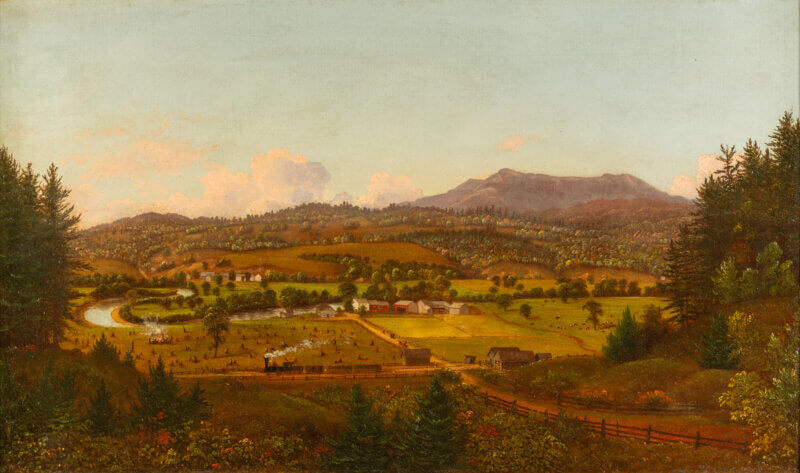Shelburne Museum first stop for train art exhibit
Shelburne Museum presents All Aboard: The Railroad in American Art, 1840-1955, an exhibition exploring depictions of trains in American visual culture during the rapid industrialization and expansion of the 19th and 20th centuries. The exhibition will be on view June 22-Oct. 20 at Shelburne Museum.
“We are delighted that Shelburne Museum is the first stop for All Aboard, and that works from Shelburne’s permanent collection are included and will travel on to our partner museums along the way — the Dixon and the Joslyn. The exhibition is a wonderful collaboration among museums,” said Thomas Denenberg, director and CEO of Shelburne Museum.

Charles Louis Heyde, Steam Train in North Williston, Vermont, ca. 1856. Oil on canvas.
All Aboard considers the multifaceted role of the railroad as an engine of connection and modernity, but also a vehicle for displacement, abuse of labor and environmental devastation. From the emergence of the railroad as a technological marvel in the mid-19th century to its pivotal role as a driver of industry and urbanization at the turn of the century, the exhibition traces the evolution of American painting from the Hudson River School to abstraction.
Comprising 40 paintings sourced from public and private collections nationwide, All Aboard is organized into four thematic sections. The exhibition demonstrates the influence of the railroad on the history of American art, from its emergence as a technological marvel, cutting through the landscape in the mid-19th century, to its position as a driver of industry and urbanization at the turn of the century and its eventual adoption by artists who sought to exploit its modernist potential. Additionally, the exhibition delves into the depiction of rail workers and passengers, providing insight into the diverse social interactions facilitated by train travel.
All Aboard explores how the railroad fundamentally changed the fabric of American life, moving people and products between growing metropolitan centers along the East Coast of the United States as well as westward toward the Pacific Ocean. This technology advanced rapidly, shifting the way people experienced distance and time and leading to an increasingly interconnected population in both cities and rural communities. Alongside this industrial progress, the railroad was a recurring motif in all the major movements of American art in the 19th and 20th centuries, ushering in modernity and inspiring modern art.
Notable among the featured artists in the exhibition is Vermont’s own Charles Heyde (1822–1892), one of many 19th-century painters who sought to make sense of the conflict between the promise of the railroad and the potential for change, even loss. This moment in American visual culture is on full display in Heyde’s Steam Train in North Williston, Vermont, circa 1856, where a small train augurs change, symbolized by its path through a field of cleared trees. Within years of the arrival of the Vermont Central Railroad in 1850, North Williston would boast grist mills, a poultry warehouse, cheese factory, creameries and New England’s first cold storage plant, enabling the exportation of meat and other perishables throughout the Northeast.
All Aboard features renowned artists including Thomas Cole, Ernest Lawson, Jacob Lawrence, Edward Hopper and Georgia O’Keeffe.
Organized by Dixon Gallery and Gardens, in Memphis, Tenn., The Joslyn Art Museum in Omaha, Neb., and Shelburne Museum, this captivating exhibition commences its tour at Shelburne Museum before traveling to the Dixon and the Joslyn.

